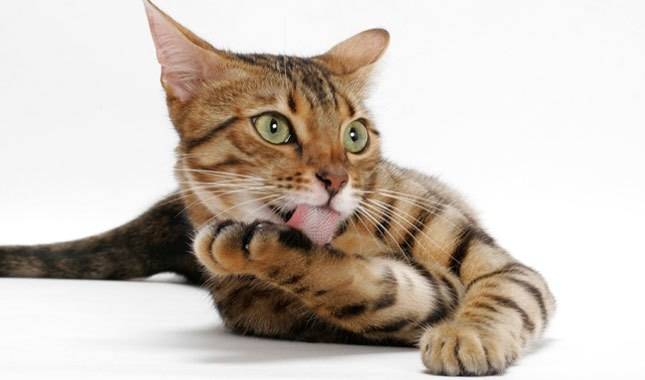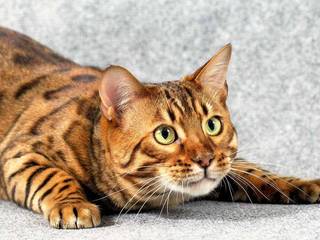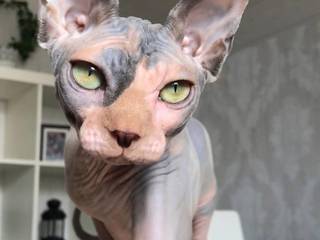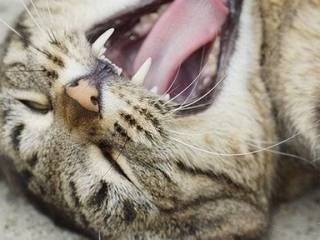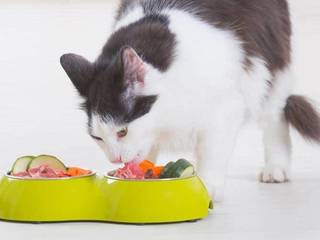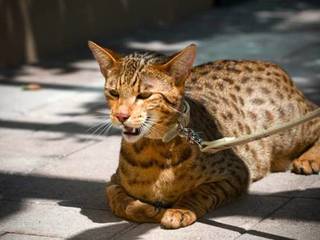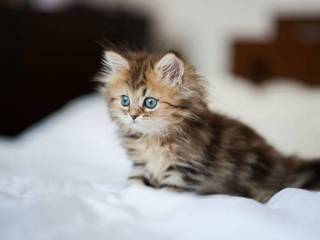Bengal cat looks exactly like its ancestor, the wild leopard cat, but only at a reduced size. The exterior of the Bengal cat resembles the wild, but this cat is very affectionate and home. Jean Mill created the breed, living in Arizona, and had the idea to breed a cat, which looks like a wild cat but would have mild character. In 1956, she crossed the wildcat Felis bengalensis, widespread in Asia, with the American Shorthair, which is one of the variants of European shorthair cats. The result of crossbreeding had one drawback: the males born from this crossing were completely sterile. Therefore, she had to continue the selection of this line with other cats. This was done using a cat of the Egyptian Mau breed, which had a tabby color. The results of the cross led to a stunning breed, and Jean Mill in 1985 was able to show the brainchild at a show in the USA. In 1991, a new breed, which was called the Bengali cat was brought up and was allowed by Americans to take part in the championships. Later, the Bengali breed was firmly established in the United States and California, where Jean Mill established a nursery of Bengali cats, "Millwood". There were about 9000 Bengal cats and some other breeds in the "Millwood".
The wild color of the Bengal cat is able to captivate any heart. In France, Bengal cats are very common and the most popular. Cat attracts attention by not only an extraordinary color but also a special constitution. Its body as well as color captures wild traits, which you cannot simply pass through; at cat shows it becomes the center of the exposition. The body of the Bengal cat is stretched long and muscular. Male cats are very different from female cats: they are real beauties, they have strong bodies and strong legs, and their hind legs are longer than the fore legs, which makes them quite bouncy. The tail is very long and thick, like a leopard tail, with the tip slightly rounded. The head is small enough, with small round ears; it is firmly set on a thick short neck.
Bengal cat has quite short hair, but kittens during the growth and maturation have slightly longer hair. The hair is short but quite dense and shiny. The sun reflects the figure of the cat as if the hair of a Bengal cat becomes golden and strewn with gold coins. Drawing on the cat's body is most often spotted or marble on a red or brown background. This color is called the spotted tabby; it is the same as the wildcat's color. The sides are decorated with drawing in the form of two oyster shells, on the shoulders, it is like the wings of a butterfly. The muzzle is painted black spots forming a clear letter "M", the whole body is decorated with dark spots, similar to the outlet. The most common color of the cat is brown with a spotted pattern. However, there is color, which was recognized at the cat show quite recently. It is the color of the snow leopard when dark spots are on too bright whitish background. Unlike other colors of Bengal cats, these ones have blue eyes. The rest of Bengal cats have amber eyes.
What do the wild and home Bengal cat have in common? The Americans established a strict rule for Bengal show cats. Bengal cats are allowed in the championships in the fourth generation of kittens. This is necessary in order to correspond to the behavior of domestic cat rather than wild. Cats often have aggressive and provocative characters, which they inherited from their wild ancestor Felis bengalensis. Jean Mill once performed a very good job of crossing wild and domestic cats; now you can only bring up good manners, shyness, timidity, and tenderness, which are considered the norm for all purebred and ordinary cats.
The Bengal cat is cute and affectionate, like a lively and active collar. It loves to perch on its shoulders and nap there in hot weather. This cat is very mobile and active; it has a restless, incredibly temperamental, and sometimes explosive character. Its active and restless behavior often annoys the owners, because you need to know in advance whether such an active cat will fit you. In addition, Bengal cats love water. It can get into the open aquarium, take a dip in the bath and go with the owner to the shower. These cats are very "talkative"; they like meowing, calling, and even shouting. However, the Bengal cat is very affectionate to people, it is able to pour all its tenderness and love in the family circle. At home, the Bengal cat is not a problem, well accustoms to the tray. Female cats, unlike male cats, develop very slowly, they are not very fertile, and have 1-2 kittens in the litter. This partly explains the expensive prices of Bengal kittens, because there are very few of them. Males mature quickly, so they are often at cat shows. After 2-3 litters, a cat becomes heavy, large, and bulky. Male cats weigh 5-6 kg and female cats weigh 3-4 kg. The Bengal cat is one of the most expensive show cats among shorthairs in Europe. Kittens are mainly imported from France, where the breed has the highest estimate of purity and title.
